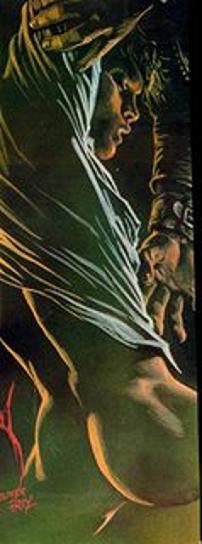
There were two boat dives the first day. The first one was to Cas Abou. Cas Abou (or Lower House) is one of the nicest beaches on





The dive site lies 100 yards straight out from the beach and is marked by a mooring buoy in 20 feet of water. A heavy rope runs along the sandy bottom from the mooring and down along the drop-off to a depth of 70 feet, making it easy to find your way back without having to surface for a peek. Currents are usually light and both directions are nice. To the right the reef runs from 30 feet to 100 feet, ending in a sandy plane where large groups of Garden Eels can be seen swaying back and forth. To the left the reef wall is steeper and drops to 120 feet. Fire Coral, Sea Rods, Tube Sponges, and Flower Coral are all found in abundance. Also look for large Green Morays, Spotted Morays, Porcupinefish, Scorpionfish, Cowfish, Sting Rays, and Eagle Rays.
The second dive of the day was to Porto Marie.

This is a wonderful site for all levels of divers and snorkelers alike, offering a quiet scenic beach to relax before and after your dive. Located about 2 miles past
Enter at the beach and swim straight out towards the mooring buoy, a hundred yards from shore. Currents and swells here are light and the visibility averages 80 feet. In the shallows you’ll see what look to be giant hollow golf balls, called reef balls. These were placed to help speed the reef’s recovery after the devastating effects of Hurricane Lenny in 1999. The reef balls seem to be working well; they’re placed along a snorkel trail, making for an interesting snorkel experience.


Porto Marie offers a unique double reef dive, with a hundred foot wide, fifty foot deep sandy valley separating the inner and outer reefs. Novice divers should consider staying inside this valley, diving the outside of the first reef and the inside of the second reef.
Spotted Snake Eels can often be found buried in the sand, with Triggerfish, Squirrelfish, Goatfish, and Gobies populating the reef.
The outside of the second reef runs from 30 feet to below 130 feet; it’s in very good shape with Gorgonians and Stony Corals competing for space. It’s intersected by two wide sandy channels that run 120 feet deep; keep an eye on your depth gauge while crossing. Barracuda, Groupers, Sting Rays, and Eagle Rays are often seen in this area.
This is a developed beach. In the past you could park your car on a strip of sand (and rocks) along the water, but since then the beach has been much improved. There are huts that provide you with the necessary shade and there is a nice restaurant. Even under water some things have changed.
Some dive summaries are taken from here.























small.jpg)


8 comments:
incredibly.
It's like reading a vacation brochure, I WANT TO GO!
In a way you are reading a travel brochure Peter as I didn't write this. Check the link. You can go too!
Just figure, I didn't read the small print, the story of my life...
maybe after i moved 2 florida i can do this. ive always wanted 2 and after this post i really want 2!
Go for it Ryan!!!
I just wanna see a puffer fish puff 'n' then pop it. >:)
That is so mean! You know, they are too cute when puffed up!!! No way you pop one.
Post a Comment